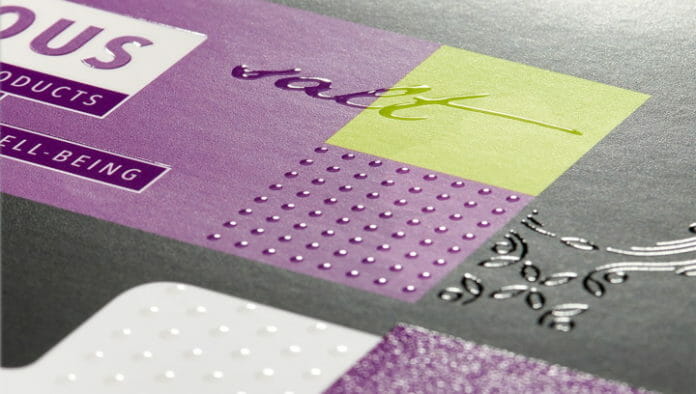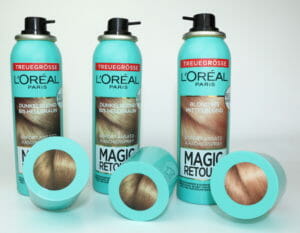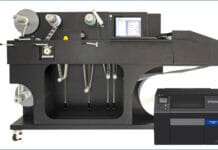
Dieter Finna (Click here for a German version)
The ability to produce labels and cartons on the same press enables label printers to expand their product portfolio. The »Carton Edition« of the digital Gallus Labelfire overcomes – as can be summarized after two years of practical experience – the previous process limitations of these applications in narrow-web printing. However, for converters, investing in a hybrid printing system also means breaking new ground and becoming a pioneer in a smart service industry.
Ever faster innovation cycles and ever shorter time-to-market increases the number of regional products for brand owners as well as the number of variants for test markets. Trends that label and packaging printers face on a daily basis, seeking solutions for markets where responsiveness is critical.
Given the premise of agility and responsiveness, it’s no wonder that it’s a digital converting system that provides a cross-procedural solution for label and folding carton printing. The Gallus Labelfire with »Carton Kit« utilises the strengths of digital printing and is additionally equipped with optimized analog and digital inline finishing techniques.
The machine equipment
Features of the machine configuration include a fiber breaker for paperboard and a corona pre-treatment for label stock. For the much higher web tension of paperboard materials, the press is stiffened, in other words the modules, on each of which two printing units are located, are clamped with steel straps. All pulleys are coated and designed for maximum diameter. Combination drying of UV and hot-air was also considered for the use of hybrid effect coatings on a machine designed for UV inks.
The existing flexographic printing units are mainly used for formatless applications such as primers, varnishing or non-digitally producible special effects. The digital printing unit with eight UV inking units (White + CMYK + GOV) can print colour images in an extended colour space as well as variable data.

Metallic effects are achieved by digitally overprinted cold foil in all shades. Another special feature of the converting system is the Digital Embellishment Unit (DEU) from Steinemann DPE at the end of the processing line. It is used for the digital application of spot varnishes with gloss and matt varnish and – brand new – to achieve tactile effects. Application rates of 20 g/m2 can be applied, which corresponds to a coating thickness of 20 μm, without this process restricting the printing speed of 70 m/Min. Even a coating application of up to 50 μm is possible, with a reduction in speed.
In die-cutting, it is possible to choose between a semi-rotary or fully rotary die-cutting unit, whereby the maximum speed utilization requires a rotary die-cutting unit.
Extended batch production
A comparison of print runs of conventionally and digitally printed labels published by FINAT in 2015 shows that the print run in digital printing averaged 13% of conventional run lengths during the investigation period. In other words, a conventional order corresponded to six orders in digital printing, divided into smaller batches. Of course, with small print runs, the change efficiency between the jobs is of particular importance. This is beyond doubt in digital printing.
A digital converting system can therefore make particularly good use of the advantage of extended batch production. In this mode of production, only the print subject changes; the finishing effects, substrate and die remain the same. This enables digital printing to print different variants in smaller editions without additional setup time.
Target markets
The Gallus Labelfire »Carton Edition« is currently being used in the tobacco market. The coloured illustrations of the different variants of a packaging are printed digitally. The embellishment with metallic effects is done by cold foiling and digital overprint or UV flexo printing. This highly refined goods market is driving forward the development of the digital converting system with the aim of producing a completely digital end-to-end process. Steinemann DPE’s Digital Embellishment Unit is already achieving inline fascinating and extraordinary results in coating applications and tactile effects in this market, which could previously only be achieved with a separate working step.

An extremely interesting target market of the »Carton Edition« is Health & Beauty Care, especially in the area of personal care. In this market segment, labels and folding cartons have a high level of embellishment, and the print runs as well as the size of the cartons are very much in line with a digital converting system with a printing width of 340 mm. After a substrate change, the required labels for the primary packaging can also be printed on the machine.
This also applies to the field of cosmetics and perfume, in which labels and folding boxes are elaborately finished with lacquer. With a hybrid label printing machine such as the Gallus Labelfire, hybrid coatings with a sandpaper effect or soft-touch coatings that impart a velvety, rubber-like or soft feel to the haptics can be applied in the conventional range. Metallic effects emphasize the exclusivity of the packaging. In this segment too, it would be advantageous to produce labels and folding cartons on the same machine, since the integrated colour management system places the highest demands on the colour consistency of labels and folding cartons.
»Beauty has to be staged in a sophisticated and at the same time entertaining way at the point of sale as well as on the internet.«
Martin Ruppmann, Managing Director of the VKE Cosmetics Association in the foreword to Personal Care 2020
In terms of the packaging dimensions and print runs, the Pharmaceutical segment is also one of the target markets for this hybrid printing press. Due to the high physical resolution of the digital printing unit of 1200 × 1200 dpi with a drop size of 2 pl, small characters and letters as well as fine lines and vignettes can be reproduced to zero percent. The colour management ensures colour consistency with high qualitative requirements in the Pharmaceutical sector.
In the near future, the confectionery sector will also be among the target markets. New UV-ink formulations for food packaging are currently under development in this area, which means that this segment can also be included in potential considerations in the medium term.
Cost vs. benefit
Digitally printed products are not cheaper. Where is your added value?
What all these market segments have in common, is that the design variants of their products are characterized by a rapid change. These Fast Moving Consumer Goods (FMCG) are dependent on constantly re-staging their brand image. In the introduction of new products into these markets it is sometimes a matter of avoiding potential supply gaps. Therefore brand manufacturers accept overproduction of packaging material, because in this phase, consumer behaviour and thus the required print run with respect to the new product is difficult to estimate.

Today, lowest inventory or even »zero stock« is an approach brand manufacturers take, in which they only order as much packaging material as is currently needed for the campaigns. If design variants are tested and a variant runs particularly well, brand manufacturers are dependent on being able to reproduce at short notice, especially if the market behaviour of the end user fluctuates. Costs for storage and retrieval operations, slow-movers or obsoletes of packaging material are thus largely reduced or completely avoided. From this perspective, the production of packaging material in digital printing, especially small to medium runs, is quite interesting from an economic point of view.
Smart solutions in services
The development of a hybrid label printing machine explicitly for folding carton printing to a converting system with the equipment features shown is driven by practice. More precisely, by a brand manufacturer, that purposely pursues the goal of exploring all the possibilities of digital folding carton printing for its supply chain. The results in the tobacco market show that the hybrid printing system Gallus Labelfire has passed its folding carton aging test. Now the path into further markets is open, especially in the segments Personal Health & Care and Pharmaceuticals.
An enormous advantage when addressing other market segments is that the Gallus Labelfire with »Carton Kit« builds on a converting system that has already proven itself well in the label market. The extended version adds value and gives label printers and converters the chance to take on a pioneering role – single-source labels and cartons, quickly and reliably printed on a single press, in small to medium runs. This is in line with the market requirements of brand manufacturers and also meets the target of lowest inventory levels.
However, the search for further developments in digital printing and digital finishing for a completely digital solution does not stand still. This is what makes the development in these areas so exciting.






















